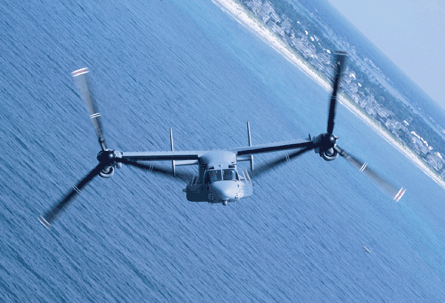V-22 Osprey engine air particle separators (EAPS) may get a fundamental redesign as Bell Boeing seeks to slash the tiltrotor's $11,000 per hour operating costs by about half.
Failures of the hydraulically powered EAPS system have caused catastrophic damage to three aircraft and are a leading source of wear and tear for the V-22's Rolls-Royce AE1107C engines.
After attempting to improve the design of the EAPS hydraulic blower, programme officials are now discussing a switch to an electric motor, says Lt Col Rob Freeland, the US Marine Corps director for medium-lift requirements.
The programme has struggled to deal with the dangers inherent in the original design of the separators, which channelled leaking hydraulic fluid into the infrared suppressor at the base of the engine nacelle and ignited damaging fires.
 |
|---|
© Bell Helicopters |
Bell Boeing's initial solution was to channel leaking fluid away from the IR suppressor and to speed the automatic shutdown of the EAPS suppressor when leaks are detected. But shutting off the EAPS increases wear on the engine and more recently Bell Boeing engineers have discovered the source of the hydraulic leaking causing the EAPS problems.
According to a recent USMC aviation detachment newsletter, debris from impeller shaft splines drifts into a journal bearing, which knocks the impeller into the housing for the EAPS blower. That causes vibrations that lead to hydraulic line ruptures.
For a permanent solution, Bell Boeing has considered rerouteing the hydraulic lines outside the nacelles, or shifting to an electrically powered EAPS system, with the latter judged the "technically most appealing option", the internal newsletter says.
The EAPS system is one of the main culprits for the V-22's poor reliability record in Iraq. A new report by the Government Accountability Office criticises the tilrotor for its cost per flight hour and continued operational limitations in certain combat situations.
In addition to an EAPS redesign, the USMC hopes to cut V-22 operating costs by installing improved ice protection systems and negotiating a new performance-based logistics contract with Bell Boeing that should encourage the contractors to meet part reliability and supply chain maturity goals, says Freeland.
The GAO report recommended that the Department of Defense consider buying more helicopters and fewer tiltrotors due to the V-22's operating costs.
Source: Flight International
















